|
How
Laser Shows Work - Laser and Exciter
The laser generates the thin beam of intense
light that is controlled and manipulated in the projector to produce the
effects seen by the show spectators.
|
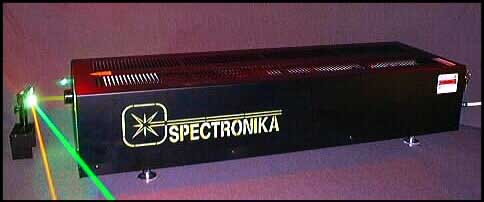
|
|
A high power,
air-cooled copper vapour laser
- Photo courtesy of Spectronika
|
What makes
the light from lasers special?
The light from lasers differs
from ordinary light in several important aspects. Ordinary light from
a light bulb travels randomly in all directions (unless the bulb is equipped
with an integral reflector that directs the light). The light is thus
incoherent. Even when incoherent light is directed with a reflector, it
still spreads rapidly.

The light from a laser is
temporary and spatially coherent. This means that all of the wave-fronts
of light are lined up in time and space (see diagrams). The waves of
light go up and down in sync, and travel in the same direction.

Coherent light spreads less
than other types of light. For example the beam of a tightly focused flashlight
would spread between 2 degrees and 5 degrees over a 3 meter (10 ft) throw
distance. The sides of a laser beam are almost parallel but the light
still spreads slightly. This spread is called divergence and is measured
in milliradians (mrad). If a laser has a specified divergence of 5 mrad,
then in the above example with a 3 meter throw (10 ft), a laser beam will
spread only about 3/20 of a degree.
How do lasers
make light?
This is a simplified explanation of the
process of stimulated emission. If you are interested in more detailed
information about this subject, you should consult a science or physics
book.
Let us take the HeNe laser
as an example. If a glass tube were filled with a mixture of helium and
neon gas; and an electrical current were applied to the electrodes, the
gas would emit light energy. This glowing gas is referred to as a plasma.
You are already familiar with this glowing gas in the form of the neon
signs you see at your favorite restaurants. We now have a neon tube but
not a laser so let's take a closer look at how the laser's light is produced.
Under normal conditions the electrons in a gas atom orbit at a fixed distance
and pattern around the nucleus; this is the ground state or most stable
configuration of the atom. When an electrical charge travels through the
gas in the tube (energy is pumped into the gas), it excites or stimulates
the atoms. Some of the electrons absorb this energy by jumping up to the
next highest orbit.
This configuration is unstable. The electron wants to return to its regular
orbit, the ground state. As the excited (stimulated) atoms in the gas
relax back to the ground state, some of the energy that excited the electron(s)
is emitted (released) in the form of random photons of light (see
diagram below).
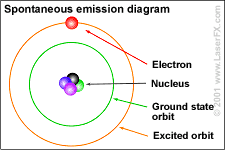
This is called spontaneous
emission. This is how a neon sign (or other gas discharge light such
as a mercury vapour lamp) produces light. The photons travel rapidly
in all directions. They are visible along the length of the neon tube
or radiate outward from the light source. The spontaneous emission is
not enough to cause lasing action.
Lasers are very different from neon tubes in that they amplify the glowing
effect via stimulated emission. Stimulated emission can only occur when
there is a "population inversion" in the energy state of the
lasing medium (in this case gas).
Laser tubes are designed in a long narrow configuration with a central
bore. At either end of the bore there are mirrors. These mirrors must
be held in precise alignment for the laser to work properly. In most HeNe lasers the mirrors are permanently attached or sealed onto
the ends of the tube -- sometimes referred to as hard seal technology.
In higher power lasers, the mirrors are usually not mounted on the ends
of the tube itself, but on an external resonator that forms part of
the laser frame. This allows for changing the mirror optics or adding
a littrow prism if a specific output wavelength (colour) is required.
The mirrors must be perfectly aligned and parallel so that the emissions from the
gas in the tube will be amplified.
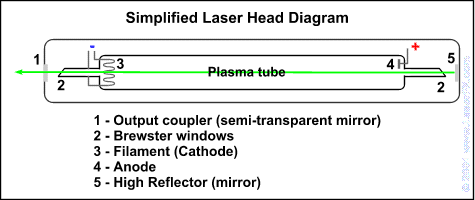
Some of the photons of light
randomly emitted by the relaxing gas atoms will be traveling parallel
to the bore (centre) of the laser tube. These photons will strike the
mirror (high reflector) at the end of the tube and will be reflected back
through the excited gas (plasma). When the photons traveling parallel
to the bore are reflected from the mirrors, they oscillate back and forth
between the mirrors.
|

|
| An air-cooled laser tube with cooling fins - the
connections for the cathode/filament are visible on the right -
Photo courtesy of Laser
Physics Inc. |
In their travels through
the plasma, some photons strike other atoms that are in the excited state.
The excited atoms are stimulated into relaxing to the ground state and
releasing their duplicate photons.
The groups of photons travel back and forth through the lasing medium
(gas) reflecting from the mirrors at either end. They build up sufficient
energy to overcome optical losses, then lasing begins. All of the above
activities take place almost instantaneously (at the speed of light) when
the tube is started. The mirrors form an optical "amplifier"
allowing for the amplification and stimulation of the lasing medium (gas)
in the cavity (plasm tube) to produce light (photons).
If the mirrors were both totally reflective, the light would remain trapped
inside the tube. In fact the high reflector is coated to 99.9% reflectivity
(it should be 100% but nothing in life is perfect) so as to reflect the
maximum amount of light. At the other end of the tube, the output coupler
is coated between 90% and 97% reflectivity (semi-transparent mirror).
Thus between 3% and 10% of the light in the tube is allowed to "leak"
out as the laser beam which you see in light shows.
This "leaking" light would drain all of the energy from the
plasma if it were not for the electrical power that is continuously applied
to the tube. The electrical power keeps the plasma energised (ionised)
and allows the laser to produce light continuously. Some types of lasers
do have a cycle where energy is pumped into the lasing medium in pulses,
then released in a short burst of laser energy. This type of laser is
referred to as a pulsed laser and usually produces very high power levels.
Lasers in
light shows
There
are three main types of lasers used in laser light show
applications:
-
Ion (gas) lasers such as Argon
(Ar), Krypton (Kr) or "Mixed Gas" lasers (Ar/Kr)
-
Diode Pumped Solid State Lasers
(DPSS)
-
Diode lasers
The
laser most often used in
professional light shows and displays is the Argon (Ar) laser. The argon
laser gives a cyan coloured beam that can be split into blue and green
beams using a yellow dichro or a prism. A Krypton (Kr) laser can
be configured to produce a number of different colours or red only.
In some laser shows, an Argon and a Krypton laser are used as a
"tandem pair" where the beams are combined to produce a
"white" beam.
Full colour laser shows usually use "white light" lasers that contain a mixture of argon (Ar)
and Krypton (Kr) gases in the laser tube and produces red, (sometimes yellow) green and blue
from the same plasma tube. This is simpler and more convenient that
using a tandem pair of Ar and Kr lasers.
|
Interior of an air-cooled
argon laser
On the right is a photograph of a modern air-cooled
argon laser with an integrated power supply with the top removed
so you can see the internal components.
The laser tube is inside the reddish air-shroud which is used to
channel the cooling air across the heatsink fins on the tube before
it is blown out of the laser by the fan on the back.
On the right towards the back is the torrodial power transformer.
On the left is a bank of capacitors that forms part of the power
supply (most of which is not visible as it is located on a board under the laser tube).
At the back left, you can see the power cord, fuse and switch. On
the back right the key interlock (for safety) and the remote control
connector are visible.
This laser outputs 100Mw (1/10 of a watt) from a compact package
that weighs about 7 Kg (15Lbs) and operates from 110 VAC.
|
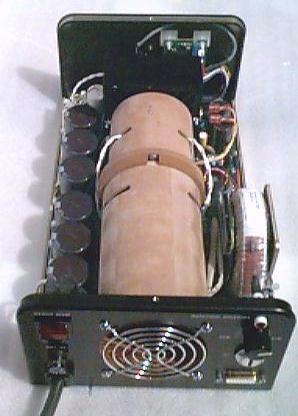
Photo courtesy of Laser Physics Inc.
|
The most common type of gas laser you
will see is the Helium Neon (He-HeNe) laser which produces a low power
red beam and is used in hobby and consumer laser shows and even in some
supermarket check-out scanners. The HeNe is rapidly being replaced
by red diode lasers (the type used in laser pointers) due to their compact
size, low power requirements, long life and the low cost of laser diodes.
Other common types of lasers used are Krypton (Kr) and mixed gas lasers
that are usually referred to as "white light" lasers as they
produce a pinkish white beam that contains a number of colours. High power
solid state YAG lasers producing intense 532 nm green beams are also used,
especially for outdoor shows. Copper Vapour lasers produce emerald green
and gold beams.
The laser is usually mounted on a rail
or base plate so that it will be in a fixed and rigid relationship with
the projector. If there is any vibration between the laser and projector,
it will affect the alignment within the projector and the alignment between
the projector and distant effects such as bounce mirrors.
Exciter
The exciter is the power supply for the
laser that takes
the multi-phase high voltage AC line power and converts it into the DC voltages
and control signals that are needed to drive the plasma tube inside the laser head.
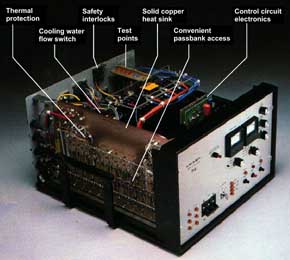
Click Here
to see the full size image (opens in a new tab) - Photo courtesy of Lexel Laser
Lasers can
be air-cooled or water cooled - the photo above shows an exciter for a
water cooled ion laser. The exciter usually contains electronic control circuits
to adjust the current to the laser tube, light feedback regulation and circuits
to
control the start-up and shut down sequencing of the laser system. The
exciter pictured above has a large, water cooled, copper "cold
plate" (heatsink on the left) where the main power transistors are
mounted (the passbank). Water passes through tubes in the cold plate
to keep the power transistors cool. Water cooled exciters also typically contain flow detection
devices and temperature interlocks to prevent the operation of the laser if there is
insufficient water flow, or if the temperature of the system is too high.
Solid
State Lasers
Recently, Solid State Lasers,
also called Diode Pumped Solid State (DPSS) lasers, have become available.
Rather than using a gas filled glass tube, these lasers use a
laser diode to pump a crystal or a series of crystals. The
general principals of producing light by spontaneous emission
discussed above are used, but rather then exciting atoms of gas,
atoms in the crystal are excited to produce light. The
advantages of solid state lasers are that they are smaller, light
weight, more rugged and reliable, have blanking capability built
in reducing the need for external components, and use less
electrical energy.
Inside
a DPSS Laser
Below is a simplified diagram of a green (532 nM) DPSS
laser - other colours can be generated by using different crystals
and pump diodes. There is a great deal more detail and
complexity involved in the design and manufacture of these lasers
but this diagram will suffice to explain the general principals.

-
A - A diode driver circuit is required
to provide the current form the power supply (not shown) to
the pump diode. This power supply circuit has to be very precise as
IR diodes are very sensitive and easily destroyed by power
spikes or static discharges. For simplicity, the rest of
the electronics involved in the laser are not shown.
-
B - Powering a DPSS laser is an
infra-red (IR) laser diode, the pump diode, emitting at 808 nM. This frequency is in the near infrared so is faintly
visible to the eye as a very dim, deep red light. Just
as with any laser, the light emitted by the diode is dangerous
to the eye.
-
C - In order to keep the output of the pump diode at
exactly 808 nM, it is mounted on a Thermoelectric Cooler (TEC)
as the output frequency of diode lasers is temperature
dependent.
The TEC is an electronic device which transports heat from one
side to another when an electric current is passed through
it. It can be use to either cool or heat a device.
In a DPSS laser, the pump diode is attached to the
"cold" side while the "hot" side is
attached to a heat sink to dissipate the heat that is carried
away from the diode through the TEC. It can be simply
controlled by sensing the temperature of the pump diode and
then using an electronic circuit to regulate the TEC so as to
keep the pump diode at the correct temperature such that the
diode frequency is exactly 808 nM.
-
D - The beam output by the pump diode
is not the circular beam that we are used to seeing from an
ion laser thus complex beam shaping optics must be used. The
pump diode has a "fast" axis in which the beam
diverges widely, and a "slow" axis in which the beam
diverges far less. The beam shaping optics are used to
make the beam from the pump diode as round as possible.
It is usually not possible to make a perfectly round beam so
most DPSS lasers have a slightly elliptical beam where the
beam can be as much as 2X bigger in one axis in some of the
cheaper lasers.
-
E - A second harmonic of the 808 nM
pump diode light is generated by an ND:YVO4 crystal.
This converts the light from 808 nM to 1064 nM with is also IR
light but is not visible to the eye.
-
F - For optimal performance, the
ND:YVO4 crystal must be "temperature tuned" so it is
also mounted on a TEC cooler with a controller.
-
G - The 1064 nM light is sent to a KTP
crystal which frequency doubles the Infra Red to 532 nM green light.
-
H - The KTP crystal must be
"temperature tuned" so it is also mounted on a TEC
cooler.
-
I - Just as in a traditional ion laser,
an output coupler is used to form the laser resonator.
-
J - The 532 nM (green) beam emitted from the
KTP is very tiny and divergent. Beam shaping optics are
used to expand and coliminate the beam to form the final laser
beam output.
-
K - The final optic is usually an IR
blocking filter. This passes the 532 nm green laser beam
and blocks any of the IR light from inside the laser that
would otherwise be emitted. This is a safety feature to
prevent the emission of invisible IR light.
For the technically inclined,
we offer RGB
Lasers for laser projection displays A detailed
paper (.pdf format) which discuss the design and development of
the first, high power, all solid state RGB laser system for image
projection systems by JENOPTIK Laser, Optik, Systeme GmbH.
Diode
Lasers
Diode lasers are generally only
used in very low power laser equipment since they are not
available in high power outputs and generally have poor beam
quality. Diode lasers are similar in structure and operation
to an LED as they are a solid state device that emits light when
suitable power is applied. The internal construction of a
laser diode is different from an LED and they may contain internal
or external optics to focus and/or collimate the beam. The
most common use of laser diodes is ion laser pointers.
[ Laser
and exciter | Projector
| Scanners | Control
console | Graphics system
| Outboard Equipment ]
|
